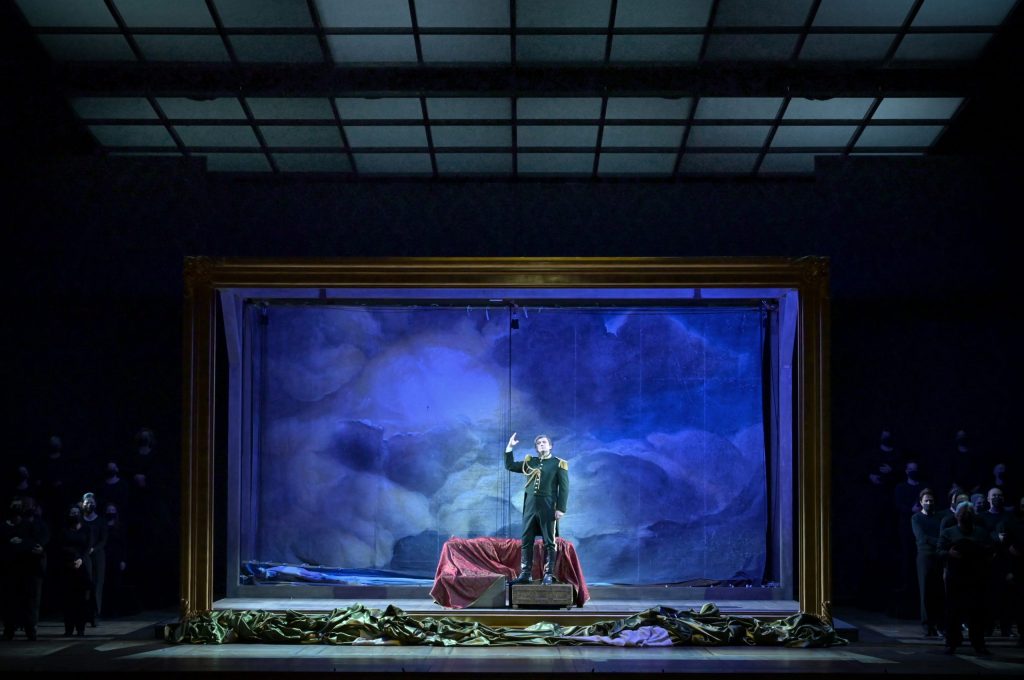
Streaming on ArteConcert : https://www.arte.tv/fr/videos/100855–001‑A/giuseppe-verdi-aida/
Prerequisite
Strangely enough, this popular opera, warmly applauded by the 15,000 spectators which the Verona festival attracts for each performance, was neglected the Paris Opera from the 1970s onwards : Olivier Py's 2013 production was the first in some fifty years, while Aida has been in the Paris Opera repertoire since 1880. One remembers that Py had worked on the Risorgimento, making Aida an opera about the Italian resistance and the constitution of the nation, in a flamboyant style that had not really convinced : in 1871, when Aida was premiered, Italy was already independent, unified, and even if it still had some territories to recover, Austria, its enemy, had been geopolitically in the doldrums since Sadowa (1866). In 1871 the Risorgimento was ancient history, one already thought about the future, even if Verdi still delivered strong political messenges (Boccanegra, Don Carlos…).
As the new production deals with other issues of the 19th century and of our time, the audience of the Paris Opera has never had an "Egyptian" Aida for fifty years, that kind of production being apparently reserved for more popular or "populist" stages (in particular the Bercy sports Arena, near the Gare de Lyon).
For Lotte de Beer does not so much focus on the plot, the story of an Ethiopian slave and an Egyptian general who betrays his homeland out of love against a backdrop of conflict between two nations, but on the circumstances of the creation of the opera, commissioned by the Khedive Ismail Pasha in 1869 on the occasion of the inauguration of the Suez Canal, and performed (in the absence of Verdi) in the brand new Cairo Opera House, in a context of "geopolitical" turmoil between British ambitions and French builders. During the construction of the canal, the British regularly asked the Turkish Sultan, sovereign of the territory, to block the work.
A brief historical overwiew : in 1871, Egypt was "semi-independent", under the authority of the Ottoman Sultan (Abdulaziz), but governed by a "Viceroy", the Khedive, to whom the Sultan left all latitude and autonomy.
Khedive Ismail Pasha was the grandson of Mehmet Ali, considered the founder of modern Egypt. He had studied in France, and was part of the Ottoman elite that looked towards Europe, politically and culturally. Not only did he build the Cairo Opera House and commissioned Verdi to write an opera, but he was also one of the major donors to the first Bayreuth Festival (as was Sultan Abdulaziz).
This reminder thus invites us to see the geopolitical tribulations surrounding the creation of Aida in a slightly different light. The "Europeanised" Ismail Pasha wanted to give Cairo an opera house, and to host the creation of a new work by one of the most revered composers of the time, Giuseppe Verdi (the other being Wagner…), the Cairo Opera House attracting the attention of the European cultural elite. Aida was not an opera imposed from the outside but demanded from within, even if this interior was strongly Europeanized. Its Egyptological colouring corresponds to the place of creation, but also to the fascination for Egyptological studies and antiquity, essential since the end of the 18th century and the Napoleonic era, under which Champollion deciphered the Rosetta Stone, and at the same time the hieroglyphs, giving rise to modern Egyptology and "Egyptomania", of which Egypt has made its business, even today, and whose Western museums (Egyptian Museum of Turin, Louvre, British Museum) have also made theirs by "bringing back" a large mass of works.
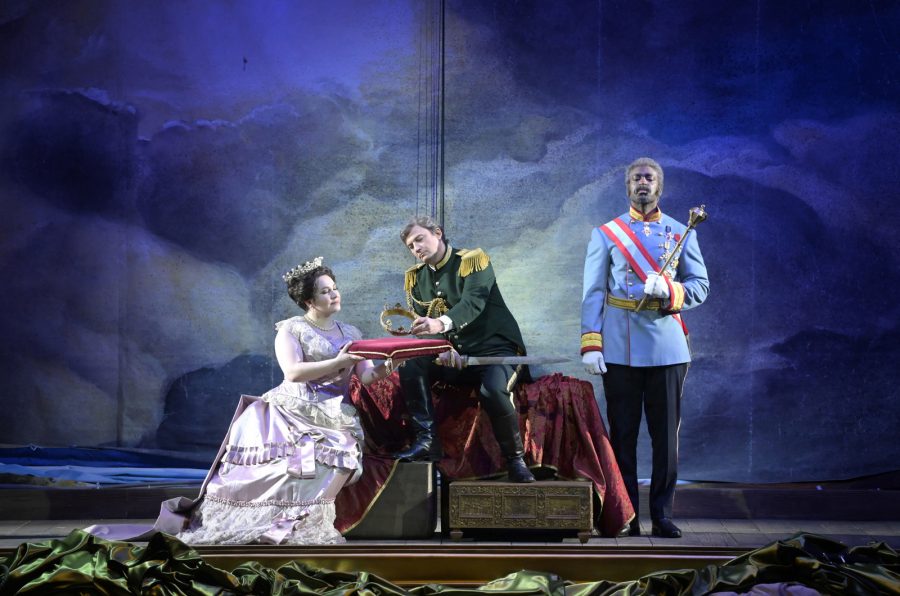
Aida was a testament to this Egyptomania, but the libretto itself had all the hallmarks of traditional melodrama : the soprano loves the tenor, but so does the wicked mezzosoprano, and the couple eventually dies, in the name of the well-known alliance of Eros and Thanatos, leaving the unloved, wicked mezzo, alone with her remorse.
This love between Radames and Aida (doubly problematic : she is a slave, moreover Ethiopian* therefore black) is a forbidden love between two human categories (free people and slaves) who cross paths without seeing each other and therefore should not look at each other : let us remember that the abolition of slavery in France was still recent, going back a little more than twenty years, and therefore was far from being a question of the distant past.
* in reality probably Nubian, a frequent confusion since the Middle Ages. Nubia is today's Sudan, on the Egyptian border, south of Aswan ; numerous conflicts between the two countries have marked the history of ancient Egypt.
Two lovers belonging to two enemy nations dying in a tomb… This vaguely reminds us of Romeo and Juliet, with which the plot of Aida has a very distant kinship. Anyway, this story, typical of the opera of the time and of Western theatre, is set against an Egyptian background, to season it with picturesque. Aida does not in itself present any pre- or postcolonial character for the time and even for the modern spectator. What the spectator wants is to be dazzled in the triumphal scene, the cash drawer of Verona. In fact, many spectator-tourists leave the arena for pizza during the intermission, neglecting the most musically successful part of the work. Aida, much quoted in the last report on diversity at the Paris Opera, shows that we are now giving it a different, "pre-colonial" character, to show the misdeeds of Western civilisation, which thus deliciously scourges itself in the opera house (or, in this case, behind its screen). But isn't that sacrificing to political correctness, to fashionable self-righteousness ?
Moreover, in many stagings, the slave Aida is not even dressed as a black slave (blackface) if she is sung by a white singer, and it is only a happy coincidence when the role is transfigured by a Leontyne Price. And while some productions point to Aida's "negritude", most do not, simply because the spectator considers it to be of little importance in this story, or at least has totally repressed the ramifications that put these issues in the spotlight today.
The fact remains that, beyond the colonial question, the question of slavery is raised in the work, in a direct way given the status of Aida, a king's daughter who became a slave and was therefore socially annihilated.
The question of slavery is addressed in the work at two moments, when Amneris announces to Aida the death of Radames and preaches the false in order to know the true, and when Amonasro, Aida's father, calls her a slave when she initially refuses to obey him. Only the wicked address this question. Radames the gentle lover sees in Aida only a beloved woman. In theory, love erases social and "racial" barriers. And this is where Lotte de Beer comes in.
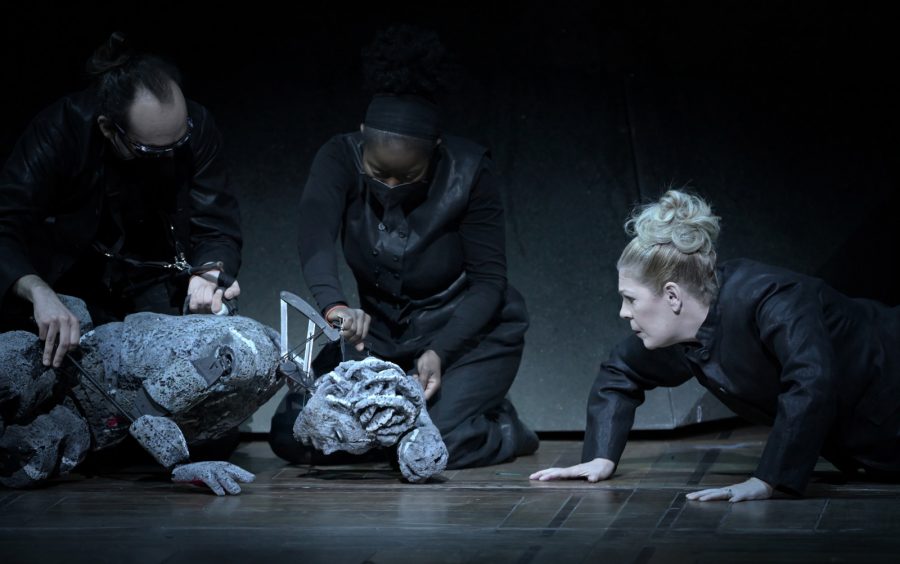
The puppet, a disruptive element
These long preliminary considerations only underline the fact that Lotte De Beer's choice is also dictated by circumstances, by our new take on colonisation ("a crime against humanity", Macron said our current president), on post-colonial studies which are much talked about, and the relation we should maintain with our past, especially when it is rather infamous.
It is therefore a "fashionable" choice, but not such a daring one. The Regietheater has already been looking at the work for some four decades : in 1981, in Frankfurt, in a production that caused a great deal of discussion, Hans Neuenfels, installing the choir in theatre boxes as an assistant at the opera, had represented the bourgeois public of the time of its creation, and the triumphal scene had also become the focus of today's gaze : the prisoners entered the theatre like beasts whipped by a tamer. Forty years later, Lotte De Beer has adopted the same approach. It is therefore not a 'revolutionary' or new vision. It is in the spirit of the times, and has been so for forty years.
This does not mean that the production is mediocre. But it seems appropriate to put things into perspective.
This being said, while Neuenfels made an Aida that was very new and even scandalous in 1981, Karajan in Salzburg two years earlier had made one in which the dancers danced in profile as on the Egyptian bas-reliefs, and in a pyramidal setting. And Verona's production satisfies the audience's thirst for eternal Egypt. Once again, there is a wide range between Regietheater and opera alla Zeffireli.
So Lotte De Beer, following the path opened by Neuenfels, questions both the Western gaze, junk exoticism, and our plundering of artworks in conquered countries, making Aida a work that bears witness to this plundering, as if it were just an avatar of ancient Egypt for a bourgeoisie in search of pleasant entertainment. She questions our aesthetic and moral representations of our colonial conquests, Egypt being a case in point. Prisoners are no longer beasts, as in Neuenfels, but objects : the slave is not human, she is a manipulated object : a puppet.
The Western gaze is neither negation, is nor humiliation, it is a museumization. At the beginning of the performance, Aida is an object in a glass case, and Radames falls in love with a work of art, like Pygmalion and others. An example of agalmatophilia…
By declaring that in the opera, Aida and her father become hostages ("they are kept as prisoners of war just like the works of art that were transported to European museums of ethnology. And there we find our protagonists, in a museum in the midst of all the other colonial booty", programme notes), Lotte de Beer explains her artistic approach, but the said approach is a little fallacious… In a similar historical situation, Charles V held François I as war prisoner after the Battle of Pavia, but François I did not become an object… it can also mean that the other seems so precious that it is kept, in a supreme form of objectifying human beings.
On a psychological level, one could justify Radames falling in love with a museum puppet. What Lotte De Beer insists on is the non-existence of Aida and Amonasro. The vanquished do not exist, they are no longer humans, they are not only other, but change nature.

This is why it involves the gaze of visual artist Virginia Chihota, from Zimbabwe (formerly Southern Rhodesia, an ex-British colony, where the white minority declared independence in 1965 and practised racial segregation similar to that of South Africa.) Her particularly interesting works are projected on the walls, behind the characters, as imposing the existence of an art coming from this ex-colonial, even segregationist Africa. Above all, Chihota drew the two puppets of Amonasro and Aida, constructed by Marvyn Millar's team. These puppets become at the same time the product of an African artist, endogenous representations and images, as it were. Here, too, one could see political correctness in what seems to us to be a truly good idea that opposes two imaginary worlds born on both sides of History.
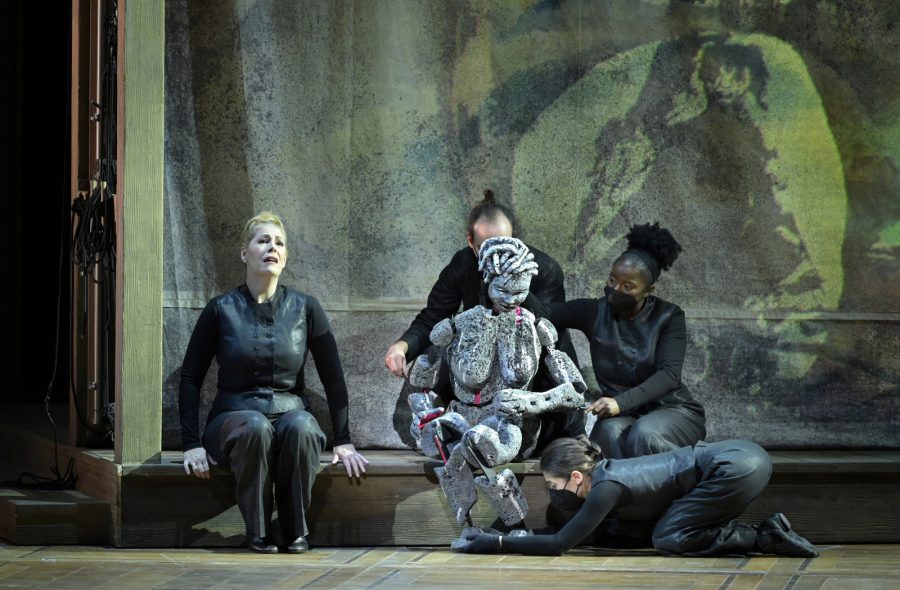
When the curtain rises, the puppet, moved by three people, does seem rather invasive. The singer has to sing in a constrained way, without expressing anything through her body (because she is like the fourth manipulator of the puppet) but only through her voice, a notable performance, with aggravating circumstances, because without an audience to support or applaud her. In this extraordinary loneliness, the artist seems condemned to sing in a desert, and Sondra Radvanovsky started with some bitterness…
For the tenor, the challenge is to address an articulated puppet in a passionate, loving manner. Thus at the beginning of the first act there is a relative stiffness, like a discomfort, an understandable lack of naturalness beyond the Jonas Kaufmann’s totally accomplished singing. Moreover, his sovereign technique shows complete mastery, with a voice that has nothing solar, but is full of power and nuance, in accordance with a situation where an inner song is exposed, rather than addressed to a partner.
The spectator also needs some time to get used to a deliberately paradoxical situation. The slave Aida does not exist as a human being, but when she is on stage, there is the puppet, two or three manipulators, one of whom is constantly crouching to move her feet, and the singer just behind her. In short, if Aida is nothing but the surface she occupies, she does “exist”! And this is obviously intentional : those you want to be invisible are there in spite of you and they occupy the space. This world, our world would like to deny people like Aida, but the more it wants to deny them, the more they occupy space, the more they occupy the gaze, like Captain Haddock's plaster in Tintin.
Once this "convention" is accepted, everything becomes clear and falls in place. There is on one side a world of representations which is that of the bourgeoisie sailing with a glass of champagne in hand between the traces of the colonial conquests, in a sort of nineteenth-century Museum of the primitive arts of ; and there is on the other side the world of truth, paradoxically personified by the puppet which represents non-existence in our eyes and which is there, constantly there, occupying our gaze, disturbing by its very presence for everyone, artists on stage as well as spectators. A very strong idea to represent what we don't want to see.
By the same token, we also understand this Radames, initially a little clumsy and rigid (a very military rigidity): through his passionate love for an object, he illustrates the psychological situation of the lover of the slave, of the black woman, of the Other ; there is a structural malaise, even a danger in the society in which he evolves to love what is denied. He is in between, between the baroque hero celebrated in the first and second acts, and the sorry being in the last act, in rags, who ends up with the puppet in his arms, like in a Pietà. "[The conqueror] weakens as he opens up to the other…" (Sami Tchak, quoted in the programme notes).
In fact Radames betrayed his caste before betraying his homeland, and in doing so he was doomed to failure.
This is why the third act works better, with its scene between the puppet-Aida and the puppet-Amonasro works better, without disruptive "humans" (and also, by the way, because the extraordinary Ludovic Tézier is less disciplined than his colleague in the art of "singing in the desert" and he "plays" a little more). The fact remains that when two puppets meet they tell each other puppet stories, they are in a way on their own turf. One could have imagined that for this scene, and this scene alone, the two puppets disappear in favour of the "real" flesh and blood characters…
All this is not silly, is not illogical in context, but is perhaps a little too demonstrative. All the same, the staging gains in meaning and interest also through the play of contrasts. It allows the character of Amneris to be isolated, to be singled out and perhaps given greater symbolic weight, like the queen of this 19th century social world, who is denounced here as the representative of this Western and colonial normality. She "represents us" in a way.
For scene I of act II, the stage indications are not very politically correct :
A room in Amneris' apartments, Amneris is surrounded by female slaves who adorn her for the triumphal celebration. From tripods rise up the scents of the perfumes. Young dancing black slaves wave feathered fans.
Lotte de Beer turns it into a Degas-like scene, with a back curtain clearly inspired by Garnier's (colours excepted), setting up all these beautiful people in a palace for ballet, a dream of the rich bourgeoisie whose opera-temple, still unfinished in 1871, would be inaugurated in 1875.
Of course, all the scenes with Amnris seem to work better, with much more fluidity : we are among white people, without puppets as a disturbing element. Thus the big scene of act IV, on a green interior tapestry background, seems to be set as a naturalistic household scene, a kind of drama that one could see in a theatre on the Parisian boulevards, or in an opera by Mascagni or Leoncavallo. The effect induced by the presence of the puppets is to send back the scenes from which they are absent to a world typical of the bourgeois theatre of the end of the 19th century.
The triumphal scene
With such an option, how can the triumphal scene be staged ?
Whatever the director's choice, the audience's expectations must be met, as must the libretto. In other words, it must be spectacular, or at least a show.
Lotte de Beer does not crystallise her staging on post-colonialism, but rather on the imagery developed by the Western world on the notion of conquest, on the mythology of wars and power, on the way power is made into myth. This scene being first of all the triumph of Radames, Lotte de Beer went in search of images of triumphs, of victors, of apotheosis, and instead of staging the Egyptian triumph on stage, which would make little sense in this production, she turns it into a sort of parlour show, where the assembled court will be entertained by looking at tableaux vivants. Instead of the spectacle of triumphant Egypt, it offers the spectacle of the triumphant West, from the 17th to the 20th centuries, from Versailles to Iwo Jima.
De Beer works on our representations, of slaves, glory and heroes ; Homer, Alexander and Darius, Louis XIV, De Ruyter (the greatest Dutch admiral), Bonaparte. Thus in record time and in an incredibly virtuoso manner (this is a real "moment") six tableaux vivants will unfold before us, depicting battles, triumphs, apotheoses, conquests and conquerors. We thus understand that the question is not only post-colonialism, but our imagination and our representations of a conquering civilisation. Our civilization seen as THE civilization.
The paintings represented are :

with its corollary the Apotheosis of Radames :

- The battle of Alexander versus Darius III, by Pietro da Cortona (1644–1650), Musei Capitolini, Roma
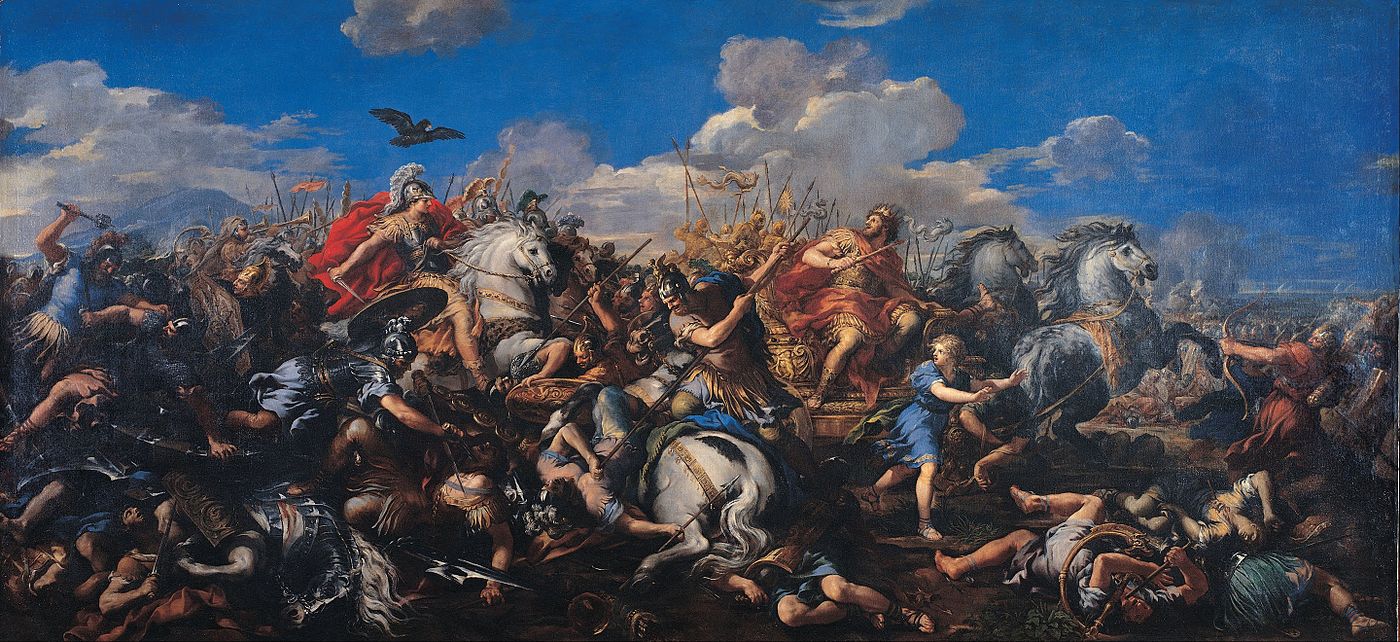
and its scenic variation :
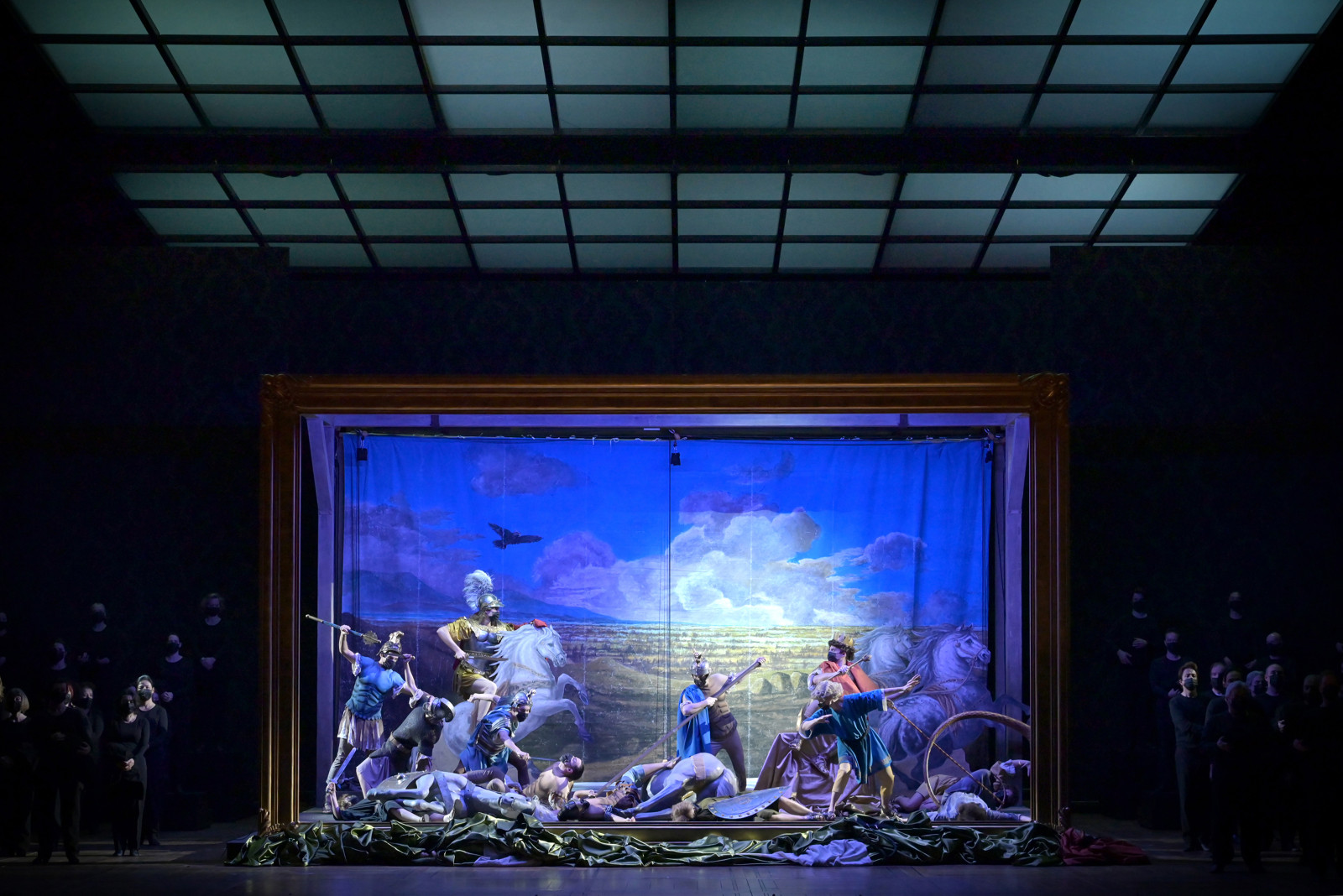
- The Assembly of the Gods (the family of Louis XIV as gods of antiquity), by Jean Nocret (1670), National Museum of the Palace of Versailles
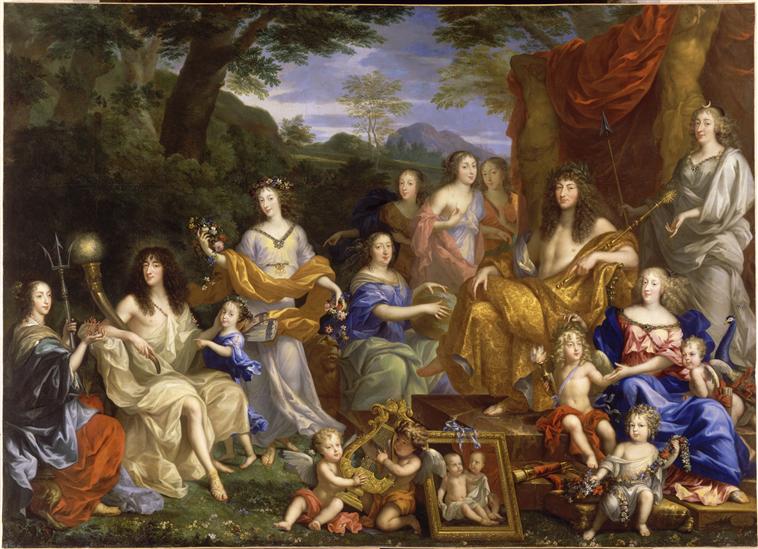
- Portrait of Michiel de Ruyter by Ferdinand Bol (1667)
– Bonaparte crossing the Alps, by David (1801)
– Liberty leading the people, by Delacroix (1830)
– The conquest of Iwo Jima, Marines planting a US Flag (1945)
When we look at this list of paintings, which playfully parade in the centre of the stage on a trestle, a living painting that we fix in ten seconds and which immediately gives way to another, we see how Lotte de Beer analyses our triumphant imagination, with a lot of mythology. We must inscribe our myths of the moment in the inactual and founding myths of the West, but at the same time she constructs indirect links between them, between Delacroix’s Liberty and its Yankee version in Iwo Jima.


Showing the apotheosis of Radames like that of Homer, or the assembly of the Gods of Olympus depicting the royal family of Louis XIV, means that we make our Gods and heroes in the image of our ancient myths, just like our warriors when Bonaparte echoes Alexander. Let us recall the beginning of Stendhal's The Charterhouse of Parma : "On the 15th of May 1796, General Bonaparte made his entry into Milan at the head of that young army which had shortly before crossed the bridge of Lodi, and taught the world that after all these centuries Caesar and Alexander had a successor.”

In the middle of all that, facing the over-represented French world in this parade of our imagination, the portrait of Michiel de Ruyter by Ferdinand Bol is an amused wink of the Dutch Lotte de Beer : this portrait of an admiral, one of the greatest warriors in the history of the Netherlands (the Netherlands is a trading nation, but also a warrior and coloniser) a relatively ascetic portrait (Protestant asceticism) in contrast to the French flamboyance, but Ruyter is shown leaning against a globe and with ships in the background… As far as colonialism is concerned, the Netherlands had their full share…
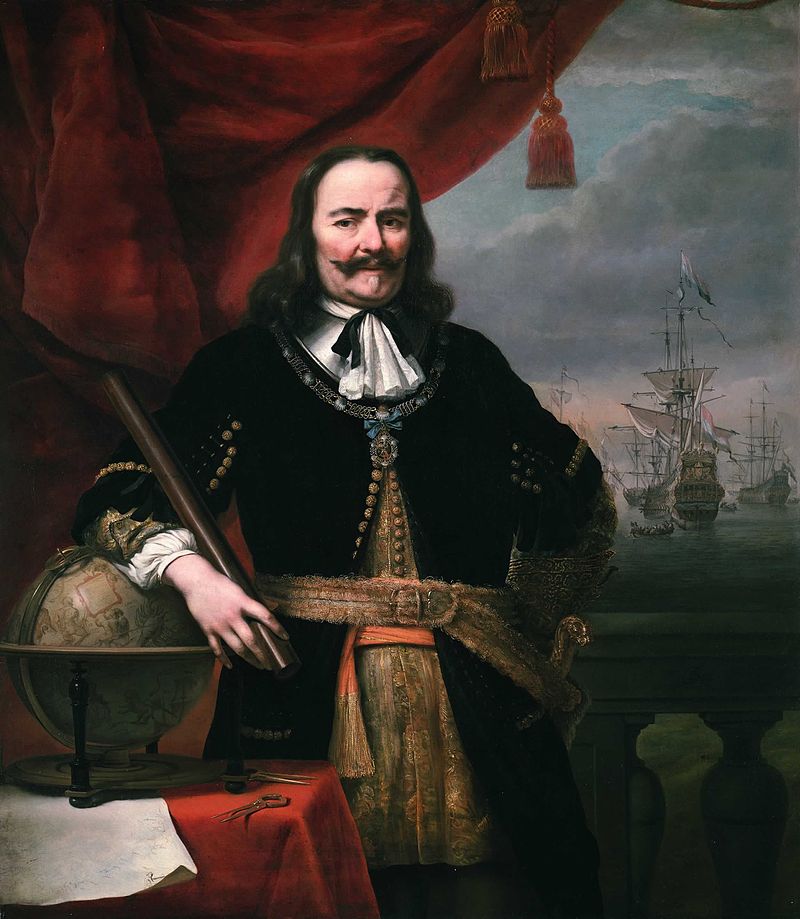
Thus the triumph of Radames is seen as exposing the imagination behind our triumphs, through references that go beyond eras, genres, and characters : Homer is there to celebrate the war epic, the Iliad, the mythical conquest of Troy, the mother of all wars.
This dizzying circulation, arranged with stupendous precision, also the audience to check their knowledge of heroic mythology, to test themselves against their imagination : Am I a "good" Westerner ? The answer will be given if you recognise each painting…

It is obviously a game, neither better nor worse than the 800 extras in Verona. In any case, it is a climax of this performance because in the third act the work shifts into a different intimacy, where the play of puppets and reality also shifts, as seen previously.
We have mentioned Acts III and IV, with the emotion that is born in Act III (the music is also responsible for that). The evocation of the homeland (Ethiopia), described as a kind of earthly paradise, green hills, fragrant shores, cool valleys, scented forests, is almost the locus amoenus of elegiac poetry, the imagination of an ideal homeland as it can be constructed in our modern mythologies. It is the act, let us repeat, where the puppets are at their least disturbing, perhaps also because the power of the music prevails (and the supreme art of the three protagonists, Kaufmann, Tézier and Radvanovsky).
Act IV in divided into two parts : first, a traditional moment when the unloved Amneris, full of remorse, tries to save Radames in this scene treated as a naturalistic confrontation.
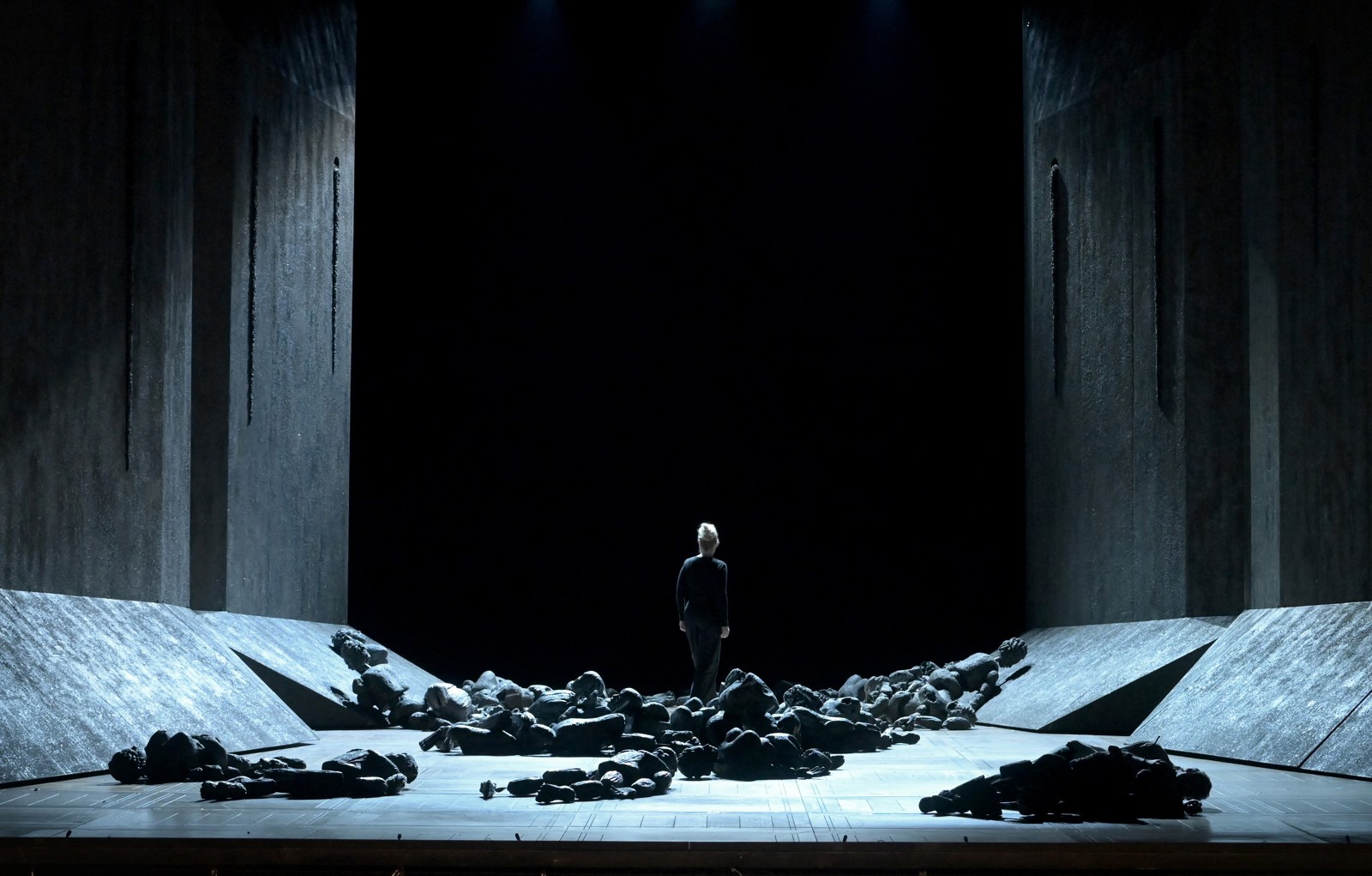
The final scene is quite different. It is the moment when productions lie those of Franco Zeffirelli often become heavy-handed, with an overcrowded set of Egyptian tombs. Lotte de Beer makes it one of the strongest moments of the whole evening, undoubtedly.
The setting is like the bottom of a ditch, where puppet corpses rot, like decomposing bodies. The valley of death… bodies that could be those of the condemned who came before, but also the remains of lost, unfulfilled dreams. The cemetery of illusions. As in Sami Tchak's sentence quoted above, the conqueror is defeated, he is going to die out and join the decomposing bodies. A very strong picture, with truly exceptional lighting by Alex Brok.
There is something obviously ghostly, where the arrival of Aida would be almost an island of life, since one has the impression that in death, Aida becomes alive again and no longer a puppet, she plays a little more, she is present on the stage and not only through her exceptional singing.
But the puppeteers arrive immediately afterwards, looking in the bodies for the puppet they finally find. They then put her in Radames' arms, creating this Pietà image, where Radames dies alone with his puppet in his arms, as the soprano moves away towards the back, as if everything were just a dream. One is reminded of the terrible and magnificent finale of Ponnelle's Tristan und Isolde (Bayreuth 1981), where Tristan lies, alone, having dreamt the Liebestod. There is something in this lacklustre, desperate finale, like an ultimate and terrible disintegration, which in turn makes us consider the vanity of our conquests, of our imaginations, of the world, in the face of loneliness, in the face of the two solitudes, that of Radames alone with his puppet, and Amneris in a dimly lit corner, barely visible, emphasising pain in a very simple way by showing together the character who is condemned to death and the one who is condemned to live. This is magnificent.
This is a show that will undoubtedly provoke discussion, that is not innovative in its purpose, nor revolutionary in its realisation, but very clear, very didactic even, sometimes a little insistent or even emphatic in the way it embraces the trends of our time. On the other hand, it is full of ideas, moving moments, a beautiful "vision of the unsaid", which plays with the reactions of the spectator, navigating between annoyance at this "puppetry" and "cowardly" relief when they vanish, when the action becomes more fluid, as if our genes, our own unsaid, all our ways of hiding our problems under the carpet were thus mimicked. "Better too many ideas than no ideas," said Boulez. Our view of this production will follow this advice.
The real triumph in this Aida is that of music.
Musically, it is the blinding clarity of a total and absolute triumph. The cast as a whole is beyond reproach, especially the protagonists, despite the difficulty for the central couple to sing in the void or staring at a greyish puppet.
Even in the “small” parts are strongly cast. Thus Alessandro Liberatore's valiant messenger and above all the Sacerdotessa (the priestess who sings “immenso Ftah”) sung by Roberta Mantegna, who now sings major roles in Italy and whose beautiful singing shows an immediately noticeable delicacy.
Soloman Howard's King is also very solid, with a strong and sonorous voice with beautiful harmonics, warm timbre, controlled volume, and beautiful projection, in a role that is somewhat sacrificed, he is among the fixtures, part of the general picture of the court, never a protagonist, but always present. He has few interventions, but they are remarkable here.
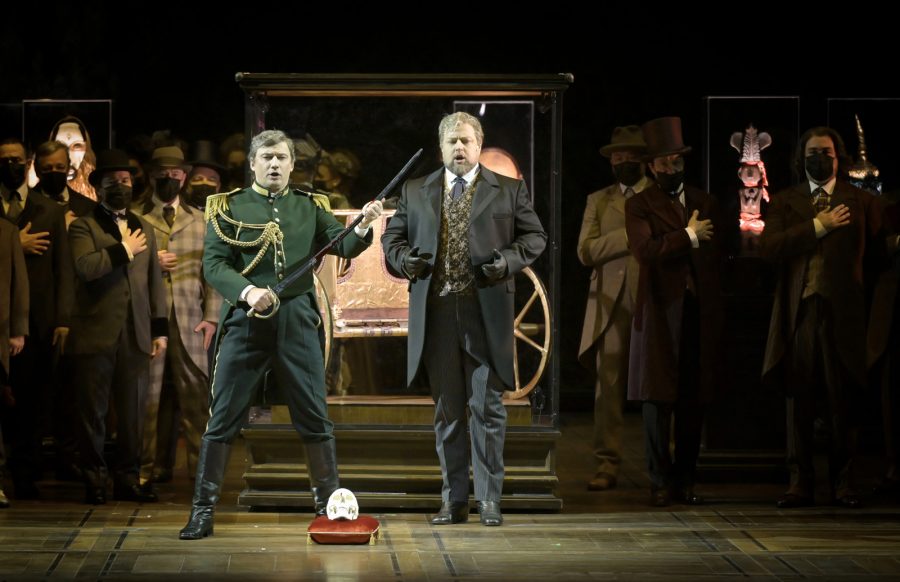
On the contrary, Dmitry Belosselskiy's Ramfis plays an important part in the plot. His bass voice, which fills the great theatres and Verdi's Requiems, is well known. The timbre is not necessarily seductive, but the voice is powerful, the diction impeccable, the volume fills the empty Bastille auditorium, which obviously requires a revision of the balance between stage and orchestra. And such voice suits the notion of a character more involved in politics than in religion, and who truly wields power.

About the central quartet, what else can be said but admiration and satisfaction ? Ksenia Dudnikova had the heavy task of replacing Elina Garança, initially cast, and she defends Amneris with a broad voice, full highs (reaching her limits once or twice, if one chooses to be nitpicking), a magnificent vocal line with impeccable phrasing and impeccable diction : an Amneris who, because of her position in the staging, becomes central, and who carries out the task with the model professionalism of a true artist. She holds the stage tremendously well because she is a "real", identifiable character, who imposes herself strongly. She has been seen in other roles, such as Carmen (in Verona), and a beautiful Sonjetka in Lady Macbeth of Mzensk in Salzburg (directed by Jansons), but she sings Amneris a lot in Russia and elsewhere, and with great success.
Amonasro is a thankless part because it is short and has to impose itself very quickly (it doesn't even get an aria). A simply correct Amonasro would be catastrophic for the balance of the two scenes in which he appears. It requires a powerful voice, as it has only ten minutes to become part of the spectator's memory.
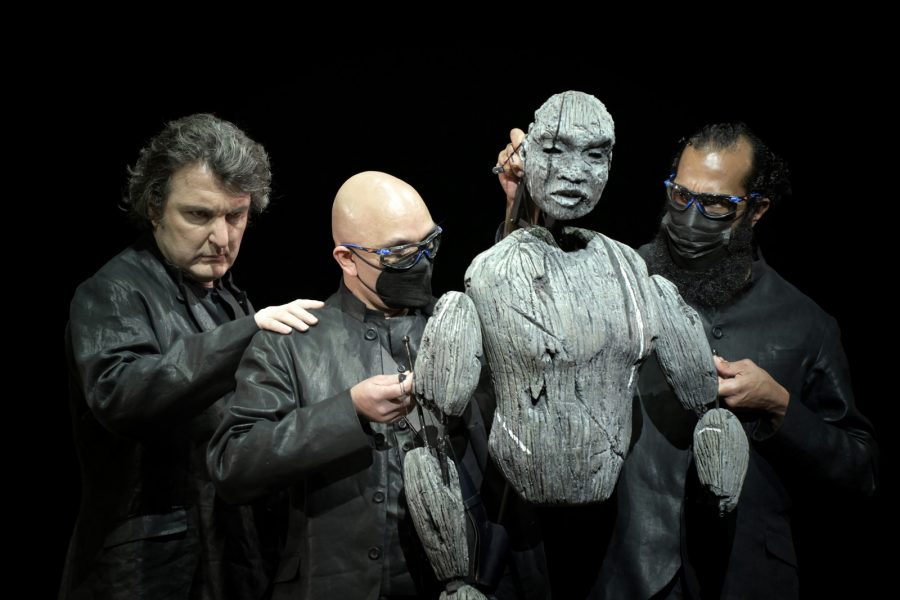
Obviously, Tézier fits that description, because he has everything, first of all he has this brilliant timbre, never veiled, and he also has power (What a Wagnerian singer he could be!). But above all he has the phrasing, the clear delivery, the expressiveness, the physical and vocal presence : he also plays at "thwarting" the staging : he is, as we have already mentioned, much more than a speaker behind a puppet, and the efficiency of his scene with Aida also comes from this scenic presence which is essential in spite of the staging. At the risk of repeating myself, only one name comes to mind when I think of it, that of Piero Cappuccilli : he has the same power, but also the same impeccable style and elegance.

Jonas Kaufmann is Radames and we heard him last July in Naples, in an open-air concert, also conducted by Michele Mariotti, not in an empty house, but in front of two or three thousand subjugated listeners. He was a valiant Radames, carried away by the crowd, fiery and delicate at the same time.
Kaufmann was extremely intelligent and knew how to adapt his singing to the circumstances, but also sometimes to the prerequisites of his own voice. Kaufmann will never be a solar Radames à la Carreras or Domingo.
In a production which involves a somewhat destabilised, more interior Radames, the absence of an audience can be an asset to build an isolated character, constantly facing his chimeras. Kaufmann's attitude, a bit stiff in his uniform, a bit clumsy, disturbed by the situation, is here supported by a singing which has nothing hesitant, but seems in constant dialogue with himself. The singer has a superior asset : his technique that allows him spun notes, mezzevoci, and a very marked control of the volume. The voice comes out when it is needed, and with power and brilliance, but it is more in the internalization that he excels. His chiselled “Celeste Aida” demonstrates his mastery of sound, which of course marvellously conveys the high notes, bent to his will. Radames is a role that suits his voice perfectly, navigating between lyricism and heroism. And he is also a singer who accepts the demands of staging, who knows how to express the desired emotions perfectly thanks to unique inflections, a sense of the word that is quite exceptional. In this production, which requires the tenor to navigate between several pitfalls, to inhabit a singing that clashes with a puppet-partner, without facing the soprano who sings Aida and thus without creating an emulation in the duets, Jonas Kaufmann not only gets away with all the honours, but more than that, he establishes a new way of seeing Radames. Admirable.
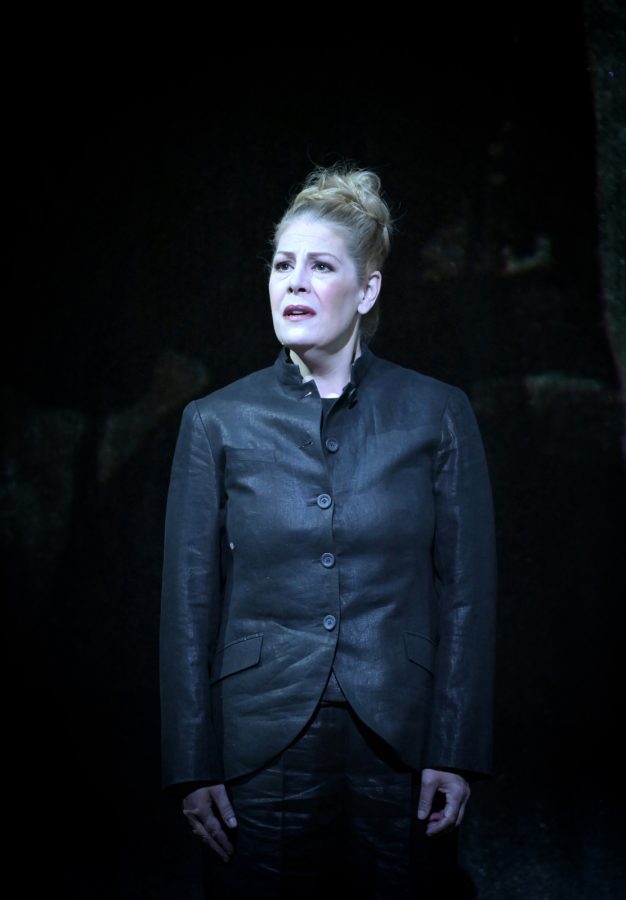
Sondra Radvanovsky is one of the two or three undisputed Verdian sopranos in today's lyrical world, she has the power, the technique and the high notes. She also knows how to give weight to each word (we understand everything in her singing). She is perfectly at ease in the role of Aida.
She has made it clear that the staging embarrassed her, as she constantly has to sing behind the puppet, behind the partner she is supposed to love ; she must be vocally present, but physically anonymous, among the group of puppet handlers. They make the puppet walk and she makes it sing. Certain less contained movements betray the difficulty of singing in a repressed way. The staging focuses on the puppet, even more than on Radames, who can play the part of the lover and have movements towards the loved one, even if it is a disjointed piece of wood. The soprano is much more constrained.
Her vocal performance is all the more exceptional. This is no concert version, it is a question of singing a presence-absence, making the voice the only tool of the game, so limited are the movements. Radvanovsky offers exceptional phrasing, exceptional expression, presence, stratospheric highs, exceptional technique. She is a Verdian because she combines an outstanding dramatic power with an iron belcantist technique, with controlled mezzevoci, spun notes, the possibility to sing pianissimi without any flaws, without the voice being weak, and above all by constantly keeping the vocal presence and the relief. Her final duet is a marvel of poetry, of ethereal singing, in a breath that almost makes it the voice of a shadow. One remains astonished by the performance in such ungrateful conditions for the singer, who demonstrates once again what an artist she is.
To support this exceptional team, the Opera choir, still directed by José Luis Basso (who will be leaving Paris for Naples after the performances of Faust), is obviously embarrassed by face masks, but the acoustics of an empty Bastille is rather an asset, and in an Aida less thunderous than others, it shows a beautiful presence and a true relief. Hats off.
And then there is the orchestra, conducted by a Michele Mariotti (whom we had already heard in Naples, crazy with energy and galvanised by the place) who takes care to find the right balance, because the orchestra obviously sounds different without an audience, more reverberant, and with a sound a little less distant than in the packed hall. In order to social distancing in the pit, the number of string instruments has been very slightly reduced, but otherwise the orchestra is that of an "ordinary" Aida. The result is also a different, less compact, more analytical sound, especially for the brass and woodwind interventions, a little more exposed and therefore more in relief in the more "epic" or dramatic parts, which is less noticeable, obviously, in the more lyrical parts.
Mariotti as a great lyric conductor is very careful not to cover the voices, which is the danger with this somewhat unusual acoustics, and he knows perfectly well how to keep a variety of colours in his Aida. He does not in any way erase what is essential in Verdi, the dramatic pulsation, the dramatic dimension, the perfect match between pit and stage, but he does not abdicate from the precision of the sounds, nor from the many refinements of the score which he exalts, even with some unexpected coquetries. The orchestra, visibly delighted, recognises him as a great conductor.
All in all, this exceptional musical quality is bound to win over the audience in a production whose scenic work is far from unworthy but less unexpected than one might have thought. Lotte de Beer gives us some real theatre, disturbing more by its "technical" than "philosophical" aspects. She wanted the audience and the singers to be "disturbed" in order to show "from within" certain other disturbances born of our history, our imagination, our guilt. It's a risky gamble, but it globally functions, in a production which is quite decent, but without sparkle. Obviously, Garnier’s old opera house who would have been more suitable (even if he only has 2000 seats) because this marvellous theatre, almost contemporary to Aida, is the very illustration of what this production underlines about the society of the time.
Streaming on ArteConcert : Streaming on ArteConcert : https://www.arte.tv/fr/videos/100855–001‑A/giuseppe-verdi-aida/
